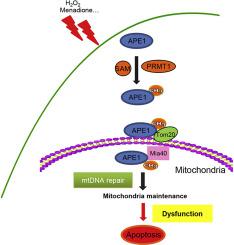Free Radical Biology and Medicine ( IF 7.1 ) Pub Date : 2020-07-15 , DOI: 10.1016/j.freeradbiomed.2020.06.027
Yilan Zhang 1 , Qi Zhang 2 , LuLu Li 1 , Dan Mu 3 , Ke Hua 1 , Shusheng Ci 1 , Lei Shen 4 , Li Zheng 4 , Binghui Shen 4 , Zhigang Guo 1

|
Apurinic/apyrimidinic endonuclease 1 (APE1) is an essential multifunctional protein in mammals that plays critical roles in DNA repair and redox signaling within the cell. Impaired APE1 function or dysregulation is associated with disease susceptibility and poor cancer prognosis. Orchestrated regulatory mechanisms are crucial to ensure its function in a specific subcellular location at specific time. Here, we report arginine methylation as a post-translational modification (PTM) that regulates APE1 translocation to mitochondria in HeLa and HEK-293 cells. Protein arginine methyl-transferase 1 (PRMT1) was shown to methylate APE1 in vitro. Site-directed mutagenesis identified R301 as the major methylation site. We confirmed that APE1 is methylated in cells and that the R301K mutation significantly reduces its methylation. Baseline mitochondrial APE1 levels were low under standard culture conditions, but they could be induced by oxidative agents. Methylation-deficient APE1 showed reduced mitochondrial translocation. Methylation affected the interaction of APE1 with Tom20, translocase of the outer mitochondrial membrane. Methylation-deficient APE1 resulted in increased mitochondrial DNA damage and increased cytochrome c release after stimuli. These data suggest that methylation of APE1 promotes its mitochondrial translocation and protects cells from oxidative damage. This work describes a novel PTM regulation model of APE1 subcellular distribution through arginine methylation.
中文翻译:

APE1 的精氨酸甲基化促进其线粒体易位,以保护细胞免受氧化损伤。
无嘌呤/无嘧啶核酸内切酶 1 (APE1) 是哺乳动物中必需的多功能蛋白,在细胞内 DNA 修复和氧化还原信号传导中发挥关键作用。APE1 功能受损或失调与疾病易感性和癌症预后不良有关。精心策划的调节机制对于确保其在特定时间在特定亚细胞位置发挥作用至关重要。在这里,我们报告精氨酸甲基化作为翻译后修饰 (PTM),调节 HeLa 和 HEK-293 细胞中 APE1 易位到线粒体。蛋白质精氨酸甲基转移酶 1 (PRMT1)在体外可甲基化 APE1 。定点诱变将 R301 确定为主要甲基化位点。我们证实 APE1 在细胞中被甲基化,并且 R301K 突变显着降低了其甲基化。在标准培养条件下,基线线粒体 APE1 水平较低,但可以通过氧化剂诱导。甲基化缺陷的 APE1 显示线粒体易位减少。甲基化影响 APE1 与 Tom20(线粒体外膜转位酶)的相互作用。甲基化缺陷的 APE1 导致线粒体 DNA 损伤增加,刺激后细胞色素c释放增加。这些数据表明 APE1 的甲基化促进其线粒体易位并保护细胞免受氧化损伤。这项工作描述了一种通过精氨酸甲基化调节 APE1 亚细胞分布的新型 PTM 调节模型。

































 京公网安备 11010802027423号
京公网安备 11010802027423号